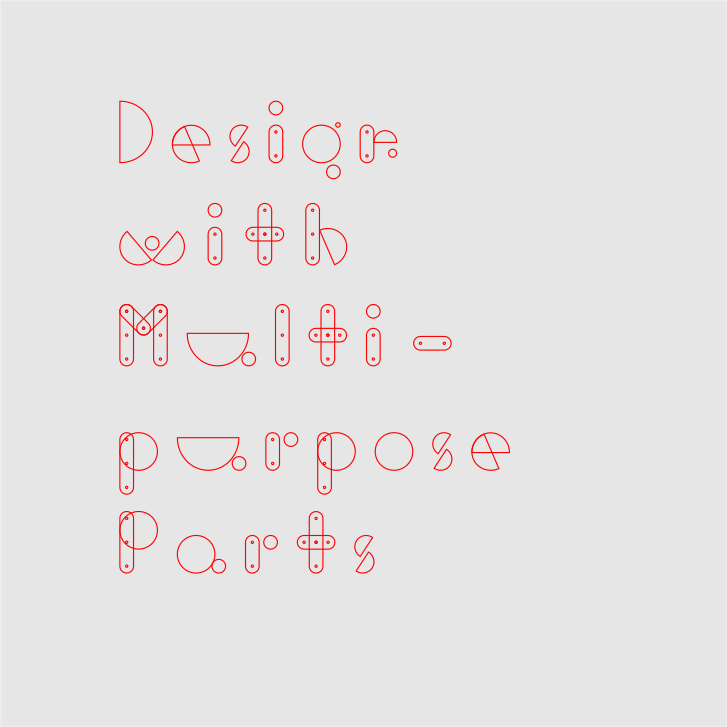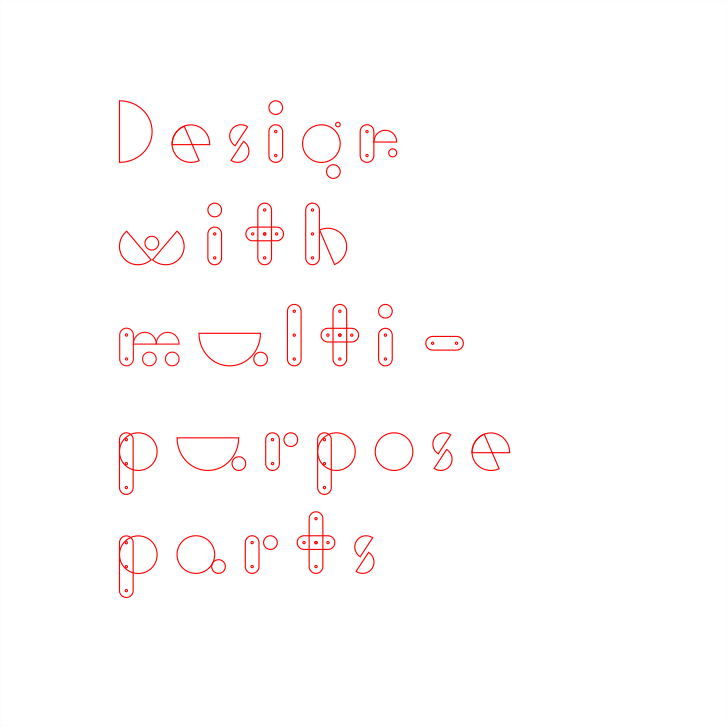
Design with multipurpose parts
What is it? How does it work? Why is it good?
vs. 1.0
what →
Sustainable design is a complex task. Many things have to align. With this document we introduce a new way of tackling this complexity: Design With Multipurpose Parts.
↓
How does it work? Designing with multipurpose parts creates everyday products using parts that can be used for more than one thing. Products are ready to be taken apart and reassembled into something else. Most of us know this from construction toys like Mecanno or LEGO. Let’s apply this to products with real utility. Let’s turn our world into a remixable playground that enables creative expression and sustainable consumption and production.
Here is what we came to understand about design with multipurpose parts (DWMP).
how to →
Design With Multipurpose Parts is something a ‘real designer’ can’t do
“Most design is unsustainable because of how designers approach their job.”
←
Design with multipurpose parts requires designers to think and act in unconventional ways. Unfortunately, we teach and discuss design today in a way that makes it almost impossible for designers to design sustainably and collaboratively. And the same reasons that stop designers from designing sustainably also stop them from designing with multipurpose parts.
- “It’s mostly about looks.” Designers often focus on the unique aesthetic appearance of a product. Sophisticated shapes, curves, materials and finishes translate into high status and ultimately – sales! It is hard to make a product people actually want to buy. This leaves little to no room to consider other complex aspects of a design, such as its repairability, reusability, upgradeability or recyclability. It is about the superficial qualities of a product rather than the social structures surrounding its production, consumption and disposal. The incentive to make an impact or innovative leap in these areas is low or even negative because it might make the job of generating sales harder to do. But this is where sustainability happens.
- “Individualists” Designers strive to be special! It is about being the exception to the norm rather than a member of a team or community. The individual is a genius. This is usually achieved by creating something that is as unconnected as possible with everything else. “Can’t touch this!” So, for a “great designer”, it is impossible to work with parts that other designers have created, because how does that make you unique?
- “Going nuclear with IP.” Intellectual property rights allow designers to earn a living. This is a common belief. But it actually applies to far fewer designers than most designers think. Which is the first sign that most designers aren’t really educated about IP. As a result, they opt for the broadest and strongest protection, which is what dedicated IP lawyers advise them to do, (because thats the product they want to sell). But intellectual property is a functional part of a design. And it is a design tool that, if not used carefully, can destroy the forms of collaboration between designers and companies that are necessary for sustainable development. The unreflected overuse of IP means that as a designer, by default, you can’t take the designs of others and build on them. As a result designers see other people’s designs as something to avoid and overcome, rather than something to work with and accelerate. Sustainable forms of cooperation aren’t trained.
These three points explain why we don’t see many convincing solutions to sustainability problems at the design level of our products. The reason for this lies in the way the discourse within the design industry is conducted and how heroes are chosen. And that explains why many designers struggle to see what is interesting and rewarding about designing with multipurpose parts.
But some designers are smarter. And somewhere the better future starts… Our heroes are different! They work like this:
Design With Multipurpose Parts is collaborative.
“Designers enable each other.”
←
Collaboration means building on the work of others to achieve something great together. Sustainability needs deep forms of collaboration¹.
If you design with multipurpose parts, you are happy to use other designers’ parts. You take pride in integrating other people’s parts and extending their known uses. This is when your creativity shines brightest, and creates the most value! Because it increases the value of all the products that already contain that part. You don’t just make one product better, but many at once.

The chair GROW is an example of Ikego’s collaborative dynamic. It’s parts were created by 4 designers and added via other sets. Lars re-combined these parts into something new, none of the other designers had intended.
When you design a new part (because you could not find an existing one for your solution), you try to create a part that works for more than just your solution. Your goal is not just to create a part, but a universal tool that other designers can use to express their creativity and solve all kinds of problems. You try to anticipate other designers needs so that they can help you make your part better by adding use cases.
Multipurpose parts are discovered together.
–
¹ Sustainable design thinks about the future. It creates positive pathways for the parts and materials in a product, even when the product’s use phase is over. Adding new uses to existing parts means avoiding waste and giving more options to the people who already own those parts. This is the strongest possible effect here: Giving people more freedom with the stuff they already have.
Design With Multipurpose Parts searches for the “super universal part”
“The minimum number of parts to produce the maximum number of products”
←
What is the ultimate goal – the inspiring and guiding north star for designing with multipurpose parts?
How about “the super universal part”! A part to build almost anything! Imagine a catalog of just 100 parts that allow you to build an entire civilisation? What would such parts look like? How would they go together? Let’s find them together, through collaboration ↑.
“Have you ever wondered why, in so many science fiction stories, when their spaceship is badly damaged on a distant planet, they are able to repair it without access to a spare parts store? How are these ships designed? And why don’t a few broken or missing parts render all the others useless?”
Design With Multipurpose Parts ♡ interactivity and agency
“A unique form of beauty:
make agents not consumers.”
←
A product made from multipurpose parts can and should look beautiful and appealing, just like any other product.
But there is something else. An additional quality. It offers more. It addresses you as a creative, intelligent and productive being, not just as a hollow “passive” customer. It carries an invitation to understand and remix it. It wants to empower.
This is beauty that goes beyond the aesthetics of a product. This is beauty through freedom. An increase in your human agency.
Products that are beautiful and can stay quietly in the background, but still are a clear invitation to be creative with them and to remix them one day – that is the top of DWMP.
Design With Multipurpose Parts needs facilitation
“Make sure the right reuse idea is accessible at the right time.”
←
A great multipurpose part may have hundreds of uses. But if these use options aren’t accessible at the right time, they won’t prevent the part from ending up in the trash.
So a great design with multipurpose parts is only complete if it is linked to a system that can help to quickly identify potential reuse cases. There are a number of possible and imaginable solutions.
Quite soon we may have AI-powered assistants that show us suitable reuse possibilities or even invent them on the spot. A century ago we would have used printed catalogs. Today, we can for example use public databases on the Internet, like the one we are building on ikego.world.
Whatever you do, if you design sustainably¹ with multipurpose parts, you need to provide at least one way to help people discover remix and reuse options for their products.
–
¹ Sustainability always requires that you connect with other systems and communicate this connection. Recycling codes – which show recyclers what material has been used in a product – are a great example. Multipurpose parts add another layer of opportunity for reuse. And it needs to be communicated that there is a system, (which one) and how to connect to it.
Design With Multipurpose Parts works best with open parts
“Individual parts should be open, complete models can be closed.”
←
The main incentive for designing a multipurpose part is that you want to enable other designers to get creative with your part and use it in new and unexpected ways.
Intellectual property rights, such as copyrights, patents or design rights, are tools that designers use to prevent and disable creative re-use by others. So there is a potential tension between designing with multipurpose parts and intellectual property rights. This tension requires designers to take action: you need to make your part open.
Imagine you have created a very reusable part. It will never reach its full potential if others have to jump through legal and financial hoops to use it. What would you do? Would you check the legal situation for every part you wanted to use, contact the creators, negotiate a licensing deal and pay for the use… No! It would be much easier to just create a new and unique part! IP will reduce your motivation to reuse parts created by others, thus killing the collaborative magic ↑ of DWMP.
But! This does not mean that your models – your assembled design – must also be open! Feel free to close the finished product. The world is full of protected products that consist partly or completely of open parts. Nuts and bolts are in the public domain but used in closed products. Feel free to use all the normal means that the world of intellectual property law offers you to monopolise your assembled product.
But make the individual parts open: To unlock the full potential of a part, it must be open and freely usable, as if it were in the public domain – as if it belonged to no one and therefore to everyone. Give it away without asking for anything in return! Yes, you should not even require attribution, as that already creates legal uncertainties for others (what if you are unhappy with the way attribution is given). Depending on where you are located and what you’ve designed, there are different legal means available to you. Here is how Ikego solves it with its own public license. Using the Creative Commons Public Domain Dedication license might also do some of the work. Maybe you can find another way. Just make sure you do something. Give others the freedom to build on your work without risk.
Design With Multipurpose Parts strives to be easy to produce
“Enabling the use of local materials, simple tools and the creative expression of designers”
←
Sustainability is something we need to achieve on a global scale. Businesses around the world can and should work with multipurpose parts: use them, design them, manufacture them, sell them.
This works faster and better if the parts are easy to make. For example, because
- they can be made with low-precision tools¹, and
- they can be made from different materials – they are relatively independent of the material they are made from².
This allows for local repair, upgrades and customization³ and gives designers the freedom to express themselves (as they are free to choose materials, colors and even curves to some extend for the finished product).
The technological progress of mankind is based to a large extent on our ability to build and use high-precision tools and to acquire and utilize a great deal of detailed knowledge about materials. So, of course, this approach to “tolerance” has its limits. It probably won’t work for everything. But you should always try to design your parts and models to allow for “tolerance” (which also makes it easier to connect to many other parts). High accuracy should not be the default! It should be the exception, made when there is no other way.
–
¹ Low accuracy tools will result in a deviation from the specified diameters. Ideally, a part will work in most known solutions, whether it is a few millimetres smaller or larger.
² For example, if a part is material-independent, it will be easy to use abundant local materials, leftover materials or even recycled materials. The part becomes a means of keeping materials in the loop!
³ You may have a product that you want to convert into a slightly different or extended version. If you can simply have the missing parts made quickly and cheaply in a local workshop in a matching colour scheme, it will be easier to make the upgrade.
Design With Multipurpose Parts designs models not parts
“Think about the solution first, then think about the parts.”
←
This is something we discovered on our journey: The best way to design multipurpose parts is to start by thinking about a complete product you want to build. Start with that as your goal. Then try to build it with existing parts first (see collaboration ↑). If that does not work, think about new parts and try to design them in a way that they might work for other things – maybe try to come up with at least one other use case yourself. Parts prove themselves with use cases.
The first experiments for Ikego started with designing parts. We made parts that we thought would be very universal. But they turned out not to be useful at all. Things changed when we started thinking about products first. So we don’t have a strong logical argument for starting with models instead of parts. Just our experience. It might be different for you. But if you don’t have a strong feeling that it will be different for you, just follow our path to success.
Design With Multipurpose Parts is super circular
“Designing with multipurpose parts enables 10 circular practices from refuse to recycle.”
←
A productive discourse about approaches to sustainable design is taking place under the umbrella term “circular design” or “circular economy”. The discussion centres on circular practices that all start with the letter “r”. When you design with multipurpose parts, you enable all of these practices! And here’s how:.
Design With Multipurpose Parts makes us/you resilient
“The ability to adapt to change.”
←
The term ‘resilience’ is widely used to discuss the ability of a system or structure (such as our built environment) to adapt to changing conditions – for example, to external shocks such as extreme weather events. Can a system find within itself the resources and ability to withstand external stresses?
An environment built with multipurpose parts is extremely resilient. It turns your environment into a powerful collection of available parts and opportunities for change. Turn what is broken or no longer needed into something new that will help you survive in new circumstances. Imagine a large wave of seawater hitting a city. Which design of street lamp would be preferable? Lamps made from one long piece in an aesthetically unique but otherwise useless shape? Or lamps made from individual, highly reusable parts? Which design is easier to repair or adapt to new situations?
But resilience is not just about big shocks. It is also about moving into a new home. Can you adapt your furniture perfectly to the new place or life situation? Or do you have to throw things out and buy new ones?

With Design With Multipurpose Parts sustainability is “just” a side effect
“Customers become allies of sustainable causes – by accident.”
←
Anyone who has been following the sustainable design debate for a while will be familiar with the idea that sustainable design has to be at least as good as other design. Ideally, it should be even better, to give consumers a strong incentive to switch.
The creative remixability of DWMP is an additional and superior feature. DWMP offers consumers new possibilities and freedoms. It is the better product. And as a side effect of this remix and upgrade feature, it is also more sustainable. With DWMP, consumers act sustainably when remixing, upgrading, repairing or selling their products as part packs. And they do it because it benefits them directly and personally. You become sustainable while enjoying the collaborative superpowers of DWMP.

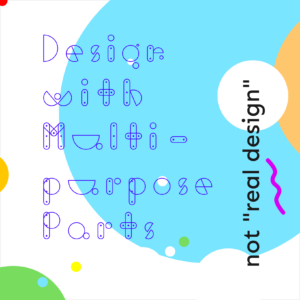
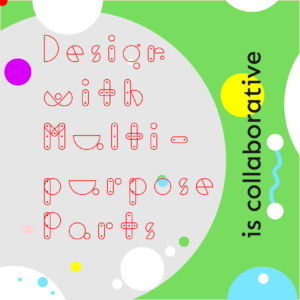
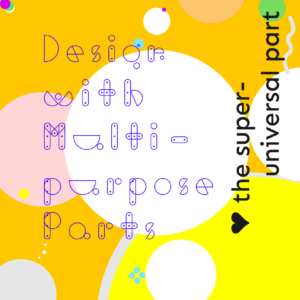
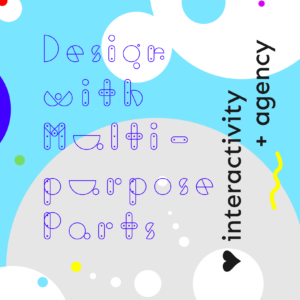
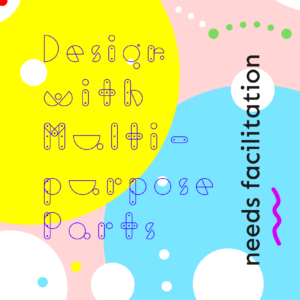
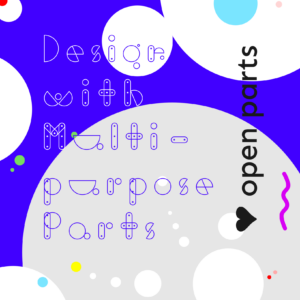
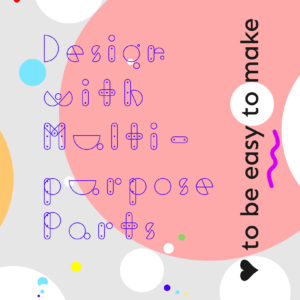
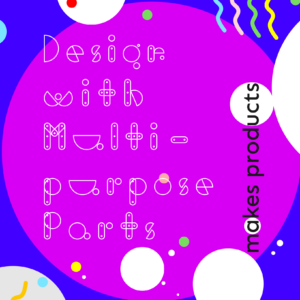
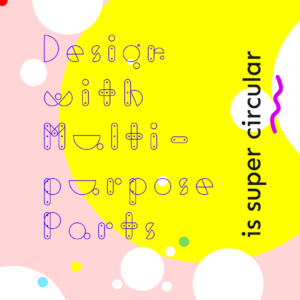
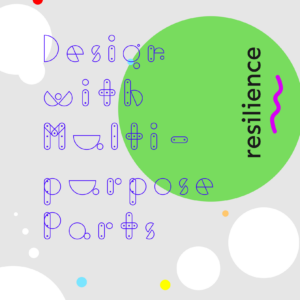
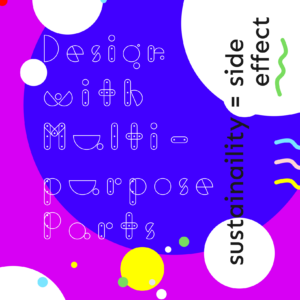
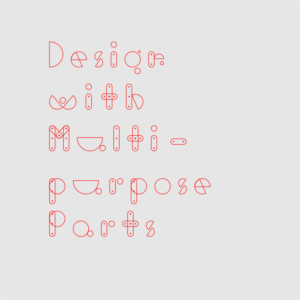

Vs 1.0 written by Lars Zimmermann
